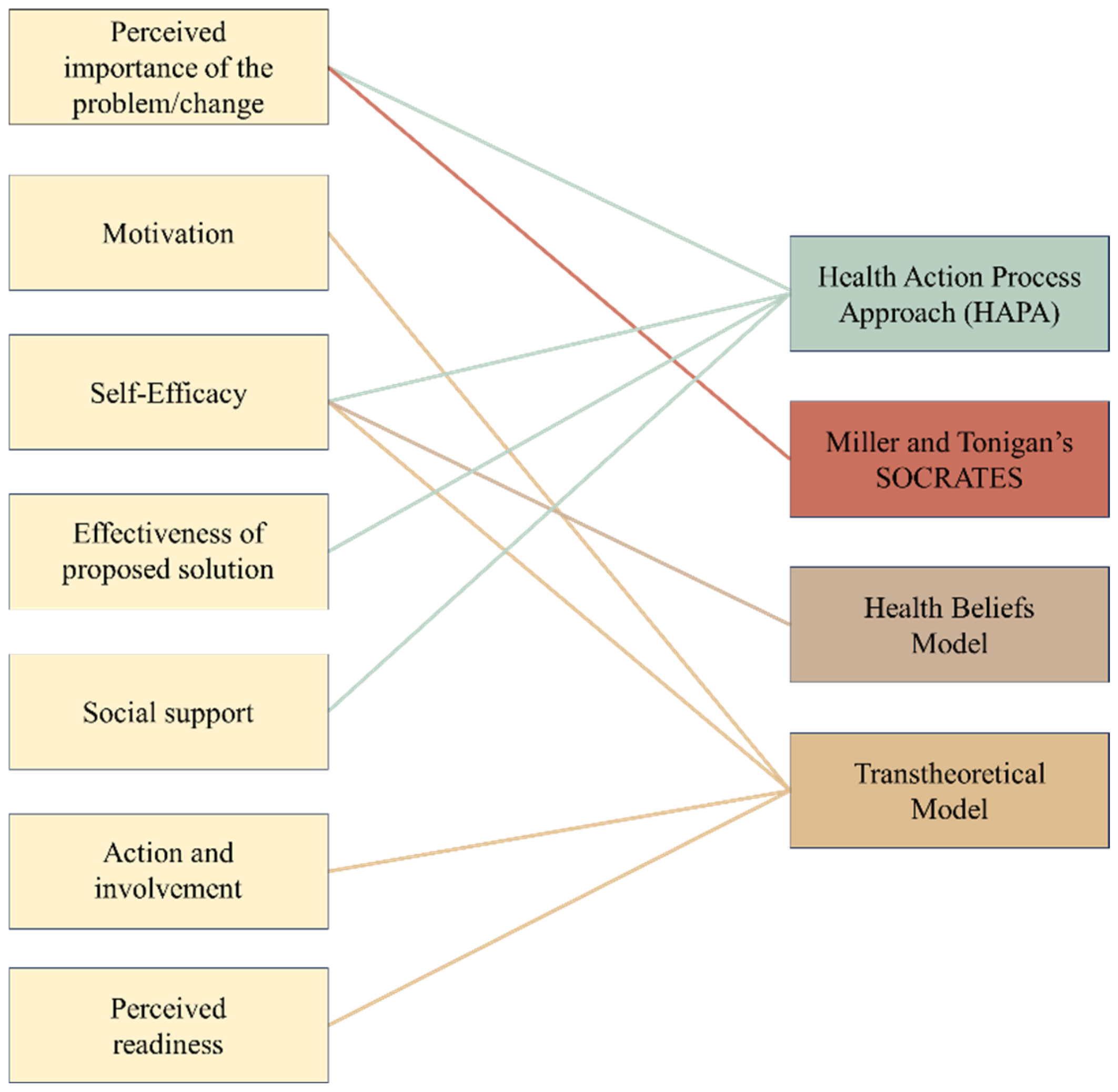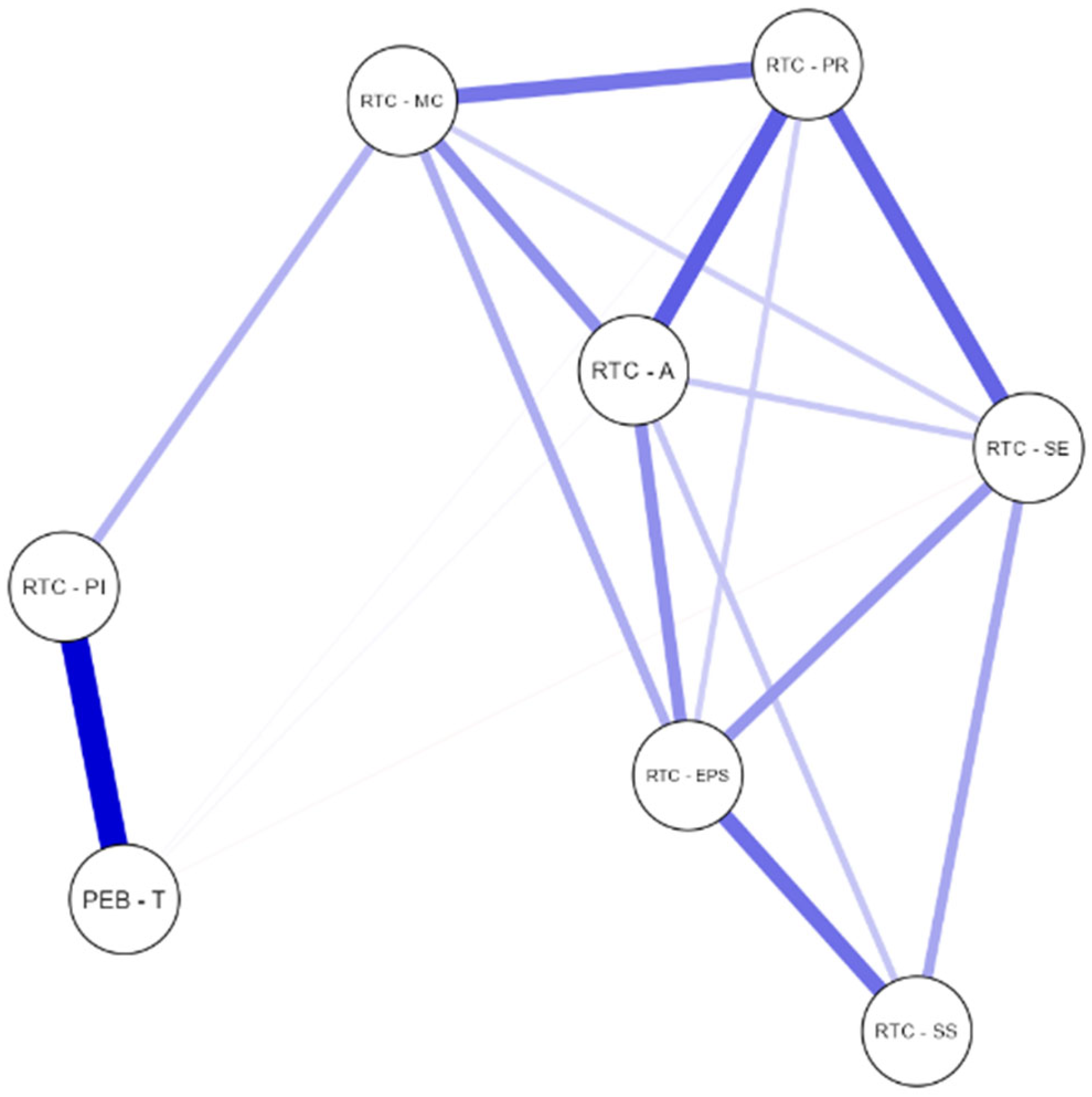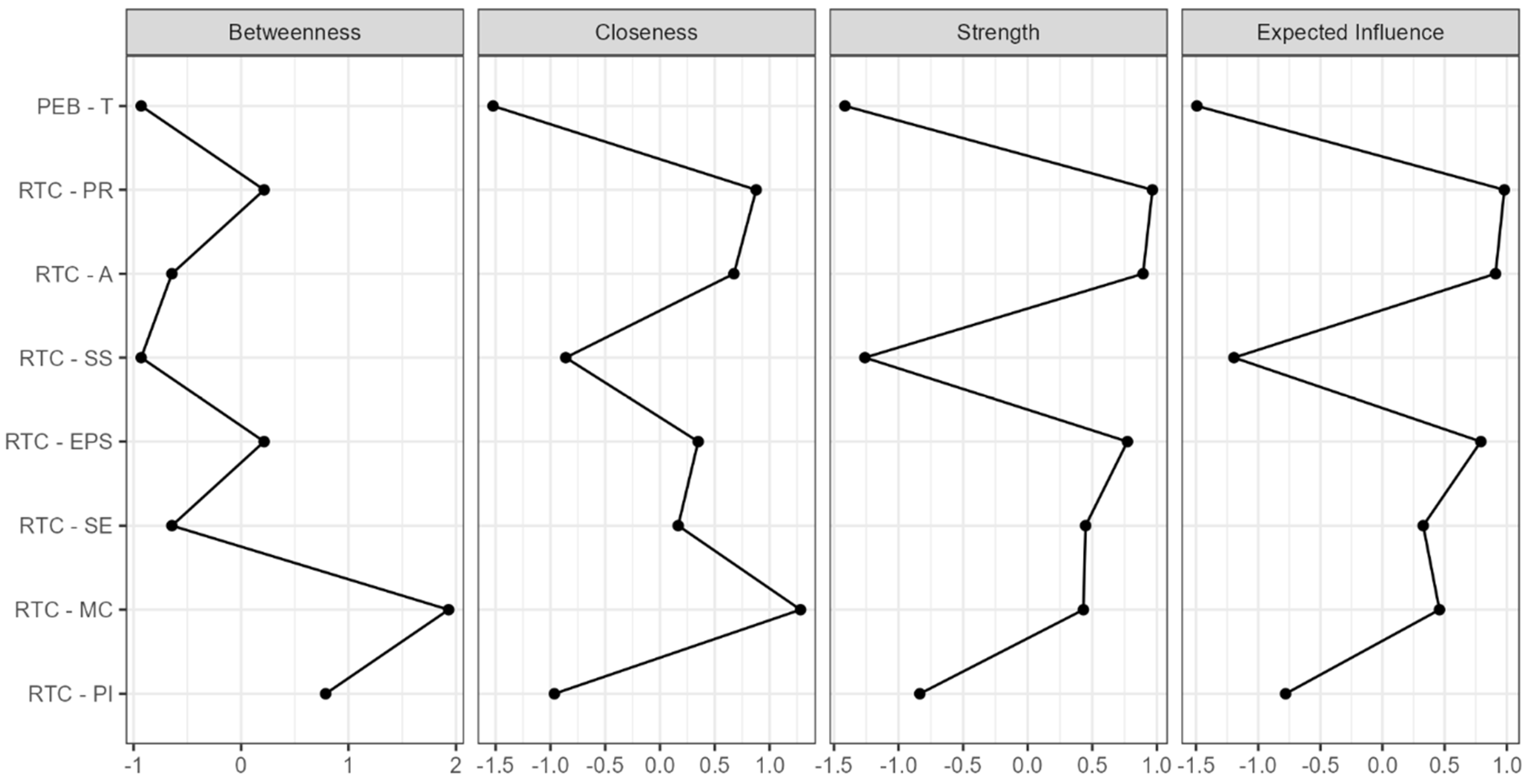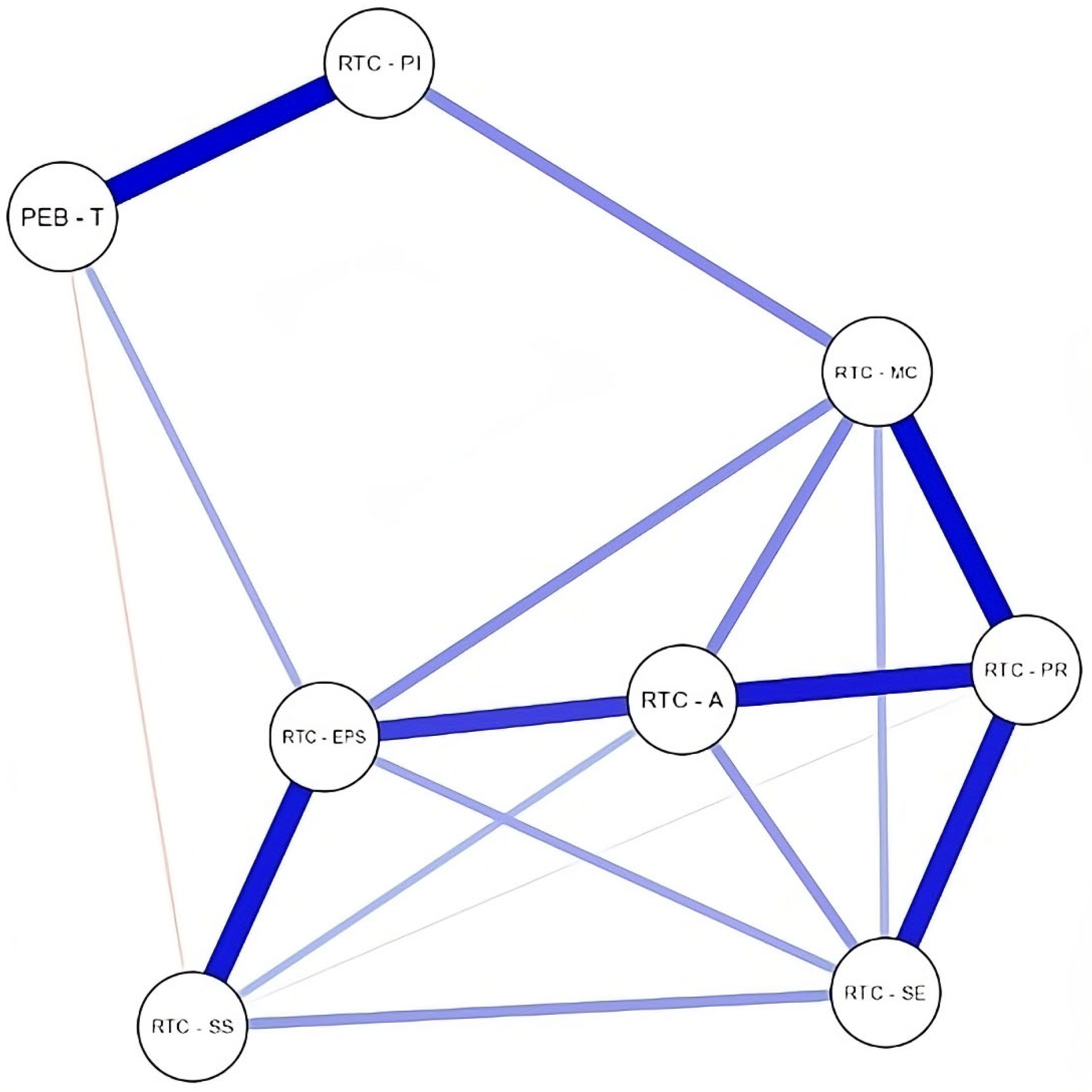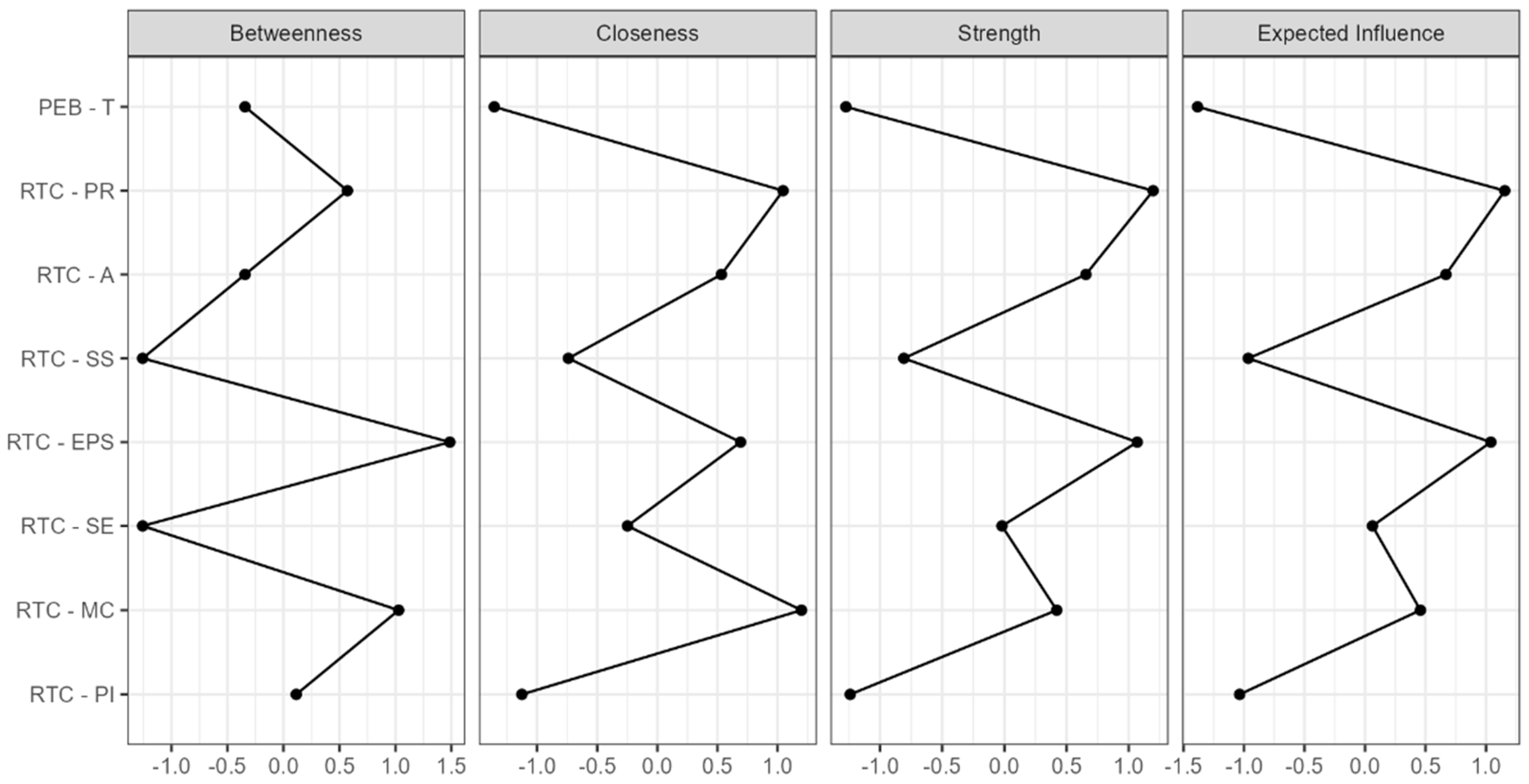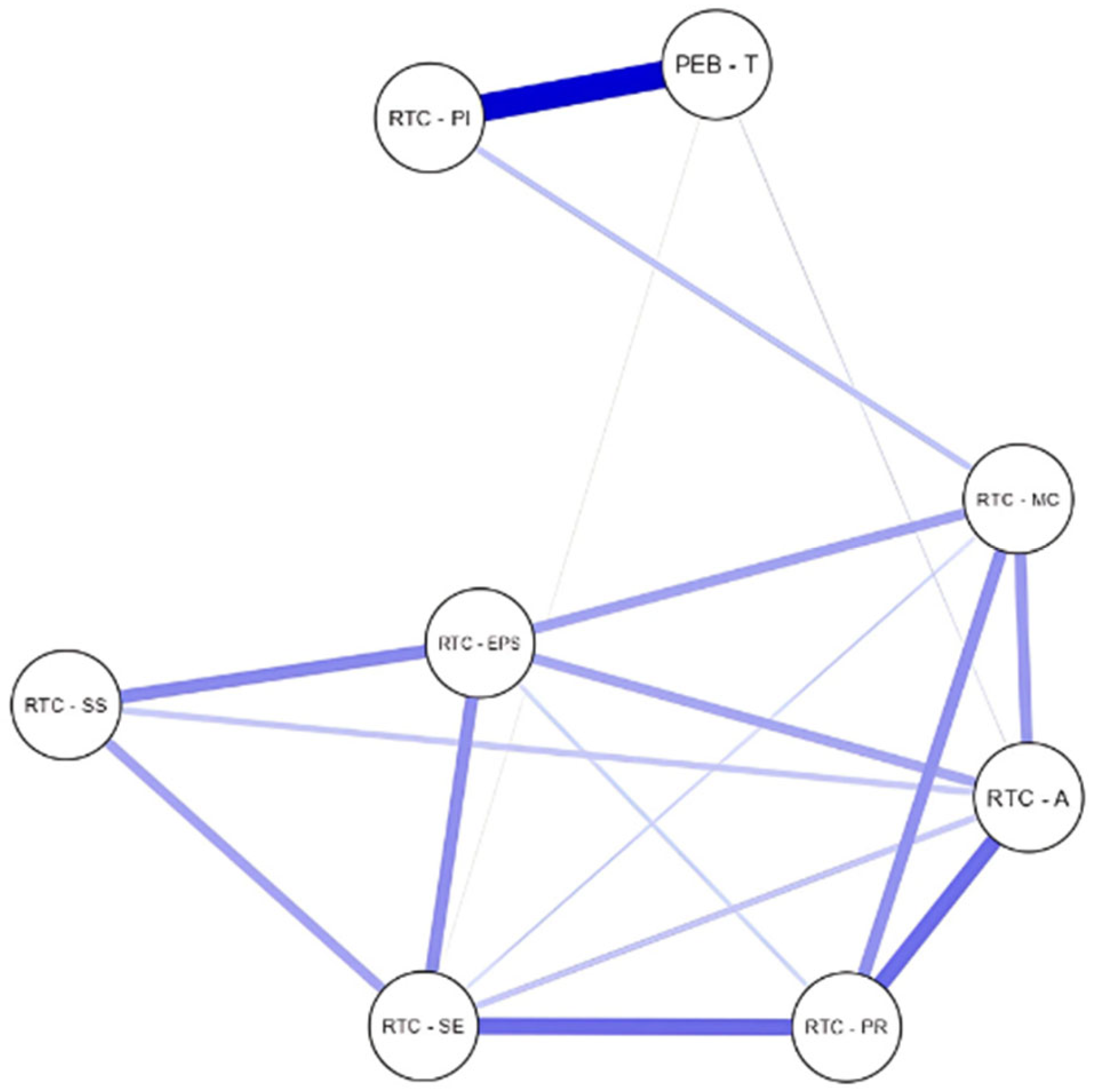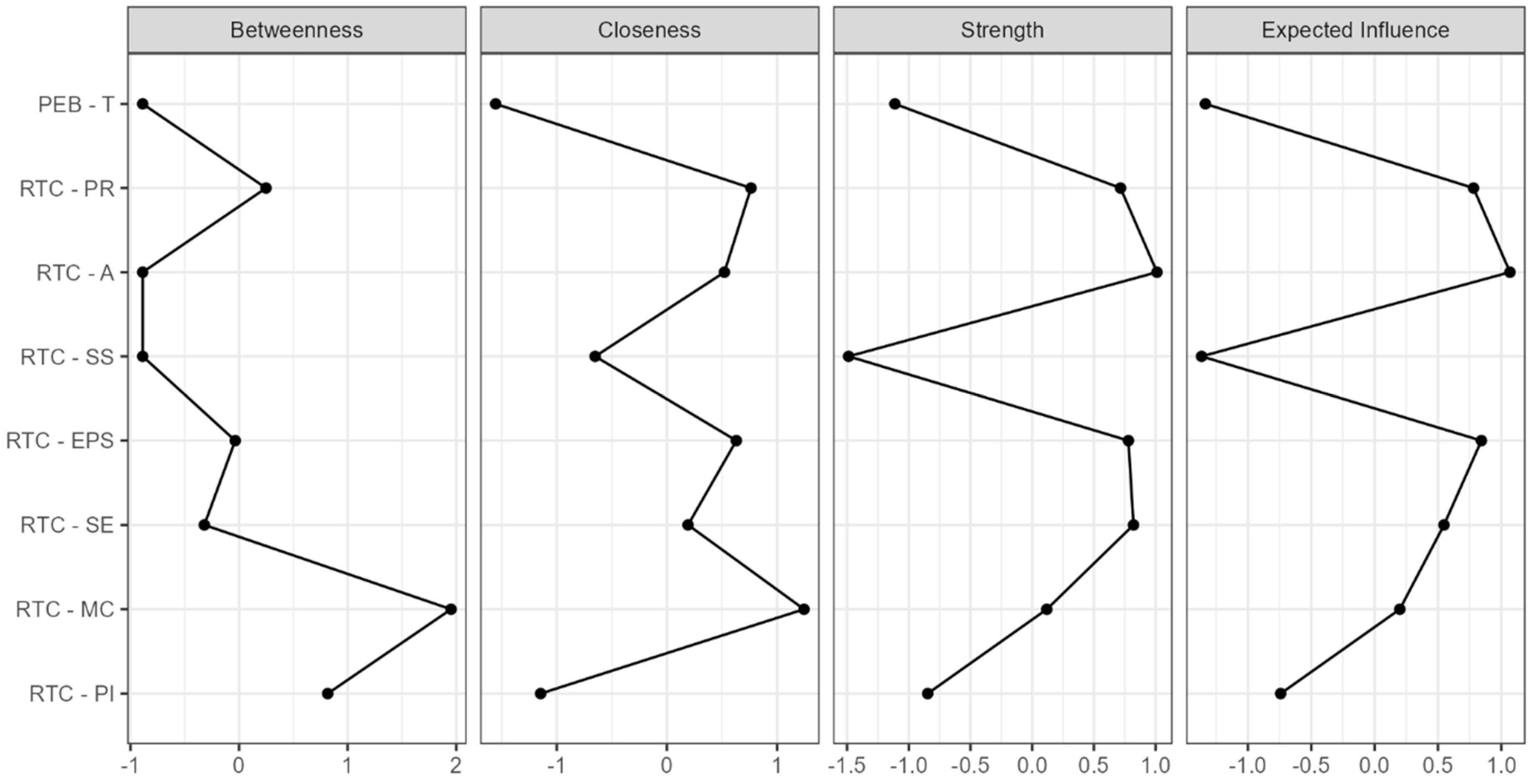3. Results
As displayed in
Table 1, all the variables considered in the study were normally distributed. Accordingly, Pearson’s correlation analysis was performed.
Correlation analysis pointed out several significant associations between PEB-transportation and RTC dimensions. In particular, in accordance with Gignac and Szodorai’s thresholds [
72] (small: 0.10; typical: 0.20; large: 0.30), a large and positive correlation between PEB-transportation and RCT—perceived importance (r = 0.528;
p < 0.001) was found (
Table 2).
Moreover, the stepwise multiple linear regression analysis pointed out that the perceived importance dimension of RCT was significantly associated with PEB-transportation (β = 0.528;
p < 0.001) by removing all other RTC variables entered into the model (
Table 3). From a linear statistics standpoint, the result highlights that just having a perception of the importance of the problem has a totalizing effect on PEB-transportation adoption.
Concerning the LDA outputs, higher classification accuracy was observed among women only (90.3%), as well as higher precision, sensitivity, and specificity values (
Table 4). However, among men and for the whole sample, moderate and good accuracy were still found, respectively. Moreover, as shown in
Table 5, the RTC dimension related to the perceived importance of the problem playing a crucial role in the adoption of PEB related to means of transportation among both men and women. However, other RTC dimensions are gender specific. For example, among men, motivation for change and self-efficacy also assume great importance.
So far, the LDA results have discriminated well between people who adopt or adopt little pro-environmental means of transportation. However, as mentioned before, the NA has been performed to observe the variable again from a non-discrete perspective, assuming the possible nonlinearity of the investigated relationships.
In keeping with this, regarding the NA performed among the whole sample, the results highlighted the presence of eight nodes with a sparsity value equal to 0.357 (
Figure 2). The RTC—MC was the node with the highest centrality in the network that was positively connected with RTC—EP (r = 0.156;
p < 0.05), RTC—A (r = 0.209;
p < 0.05), and RTC—PR (r = 0.26;
p < 0.05). The PEB-T was positively and strongly correlated only with RTC—PI (r = 0.482;
p < 0.05) (
Table 6;
Figure 3).
Furthermore, by disaggregating the NA by genders, the results pointed out that although the perceived importance of the problem assumes a crucial role for men and women, different links between PEB-transportation and RTC dimensions emerged.
Regarding the results of NA among men, the analysis pointed out the presence of eight nodes with a sparsity equal to 0.357 (
Figure 4). The RTC—EPS is the node with the highest centrality in the network that was positively connected with PEB-T (r = 0.101;
p < 0.05), RTC—SE (r = 0.111;
p < 0.05), and RTC—MC (r = 0.143;
p < 0.05). PEB-T was positively and negatively correlated, respectively, with RTC—PI (r = 0.330;
p < 0.05), RTC—EPS (r = 0.101;
p < 0.05), and RTC—SS (r = −0.40;
p < 0.05) (
Table 7;
Figure 5), meaning that if the perceived importance of the problem and effectiveness of the proposed solution encourage the adoption of pro-environmental means of transportation, social support has an opposite effect.
On the other hand, concerning the results of NA among women, the analysis pointed out the presence of eight nodes and a sparsity value of 0.393.
Figure 6 and
Figure 7 display the network conformation and centrality plots, respectively. The node with the highest centrality in the network is RTC—MC, which was positively correlated with RTC—EPS (r = 0.188;
p < 0.05), RTC—A (r = 0.211;
p < 0.05), and RTC—PR (r = 0.229;
p < 0.05) (
Table 8). The PEB-T was positively correlated with RTC—PI (r = 0.528;
p < 0.05) and RTC—A (r = 0.41;
p < 0.05) while negatively correlated with self-efficacy (r = −0.29;
p < 0.05). In summary, the results pointed out that self-efficacy affects women’s non-adoption of pro-environmental means of transportation.
4. Discussion
The current climate crisis is advancing at an alarming pace, and the actions implemented so far have proven insufficient to adequately address the emergency [
1,
2]; this clearly highlights the urgent need for large-scale behavioral change [
6].
Individual transportation choices have a profound impact on climate change, as the transportation sector is one of the largest contributors to greenhouse gas emissions worldwide [
12], with road transport being the primary source of these emissions [
14]. It is evident that influencing individuals’ transportation choices toward more sustainable alternatives requires understanding the factors that determine these choices. Going in this direction, the present study aimed to investigate the potential influence of readiness to change on transportation choices. Recently, Duradoni et al. [
32] proposed a new multidimensional conceptualization of readiness to change comprising seven factors: perceived importance of the problem/change, motivation, self-efficacy, effectiveness of proposed solution, social support, action and involvement, and perceived readiness. This new conceptualization provides an important theoretical framework for understanding the antecedents of sustainability. The authors showed that the transport cluster is among other PEBs the least effectively predicted by readiness to change.
This study aimed to examine the relationship between readiness to change (RTC) and pro-environmental transportation behaviors, moving beyond the linear continuous approach previously discussed by Duradoni et al. [
32] and considering gender as a potential moderating variable in this relationship. To this end, we performed two complementary analyses: a discriminant analysis to evaluate the linear continuous relationships underlying group differentiation and a network analysis to explore potential non-linear and continuous patterns in the data. However, before proceeding with the interpretation of the results of these two analyses, it is important to note that the present study also revealed several significant correlations between PEB-T and some of the RTC dimensions examined. Notably, regarding the link between PEB-T and the perceived importance of the problem, this can be interpreted through the lens of the risk perception construct [
32]. Indeed, within the field of pro-environmentalism, several authors have highlighted how a higher perception of risk is positively associated with engagement in pro-environmental behaviors [
9,
32,
46,
48]. As for the correlation between PEB-T and motivation, this is well supported by existing literature, which emphasizes the key role of this construct in shaping pro-environmental behavior [
32,
47,
84,
85]. Regarding the link between PEB-T and the effectiveness of the proposed solution, this can be interpreted in light of the response efficacy construct, which is itself potentially linked to the enactment of adaptive behaviors, including pro-environmental actions [
9,
32,
48,
86]. In relation to the association between PEB-T and action, this may be due to the fact that engagement in pro-environmental behaviors has been shown to be a key driver for the enactment of other types of PEB [
32,
50,
87,
88]. Finally, concerning the last significant correlation observed—the one between PEB-T and perceived readiness—this can be interpreted based on the notion that a perceived sense of responsibility appears to foster greater engagement in pro-environmental actions [
32,
51,
89,
90].
Concerning LDA outputs, the results supports the possible presence of a non-linear relationship between the observed variables. Specifically, considering the extremes of behavior (e.g., widespread use and non-use of pro-environmental transportation), it is found that the RTC is mainly able to predict the investigated behavior. In line with Lewin’s field theory [
91], it thus emerges how individual factors better predict behavioral extremes, suggesting a possible nonlinearity of the relationship. In the context of pro-environmental behaviors, the nonlinearity of relationships is also supported by several scholars, also taking into consideration that the link between attitude and behavior may mainly be nonlinear [
69,
92,
93,
94,
95]. In addition, it is also observed that some dimensions are gender-invariant, while others are gender-sensitive.
In keeping with this, several scholars explored in depth the gender gap and differences in environmental concerns [
55,
56,
57] by highlighting how gender appears to be an important factor in the determinants of pro-environmental behaviors [
61,
62]. By focusing on the results of the present study, it has been observed that if the perceived importance of the problem and self-efficacy assume a positive and negative key role concerning using more sustainable means of transportation in both men and women, other dimensions are more gender sensitive. Concerning the latter, among men, the dimensions of the effectiveness of the proposed solution and perceived readiness have a positive relationship with the adoption of pro-environmental means of transportation. In contrast, among women, the dimension of motivation for change appears to be particularly important in the negative direction. Thus, it is observed that different parameters assume different levels of importance among men and women. In summary, with regard to the perceived importance of the problem, there are thus parameters that are particularly gender sensitive.
Regarding the network analysis outputs [
80], the continuous patterns allowed us to better investigate the interrelationship between the observed dimensions by highlighting how the perceived importance of the problem continues to matter among both men and women by representing the strongest link between the RTC dimensions and PEB-transportation. Furthermore, it is observed that motivation for change is the central and connecting node among all RTC dimensions.
Concerning men only, the effectiveness of the proposed solution is maintained as a crucial element in the adoption of sustainable means of transportation by also representing the central and connecting node of RTC dimensions.
On the other hand, regarding women, in addition to the perceived importance of the problem, the dimension most negatively linked with the use of sustainable transportation is the action dimension.
In general, the results are in line with the literature data. In fact, by taking into consideration the most robust findings of the present study, it is well established in the literature that the perceived importance of the problem in terms of perceived risk, the effectiveness of the proposed solution in terms of response effectiveness, and perceived readiness are related to the implementation of pro-environmental behaviors [
9,
32,
46,
48,
89]. Conversely, the findings concerning RTC dimensions in terms of self-efficacy need further investigation. In keeping with this, our results are partially supported by literature data [
96]. Indeed, only some scholars have investigated the role of dispositional self-efficacy in the engagement of pro-environmental behaviors, considering that most studies have focused on the so-called environmental self-efficacy [
96]. Based on the findings of the study by Kosic and colleagues [
96], the role of dispositional self-efficacy in the context of pro-environmental behaviors needs further investigation, considering that this factor does not seem to be closely related to the above behaviors. It has been observed how self-efficacy (dispositional or collective) may affect pro-environmental behaviors differently based on the behavior investigated [
97]. As suggested by Chen [
98], the results that emerged may depend on the fact that although dispositional self-efficacy plays a crucial role in engaging useful behaviors to address individual problems, this factor would seem to be less relevant to taking collective actions, such as those needed to counter the climate crisis [
98,
99]. Future studies are still needed to clarify and define the role of dispositional self-efficacy in sustainable behaviors.
Moreover, by taking into consideration only the variables that differentiate men and women, we attempted to interpret the results that emerged by gender. Compared to women, it was observed that higher RTC—EPS scores among men are associated with greater use of environmentally sustainable transportation. As previously noted, this RTC dimension is also related to social consequences, a construct that is particularly relevant in the context of pro-environmentalism, given that the literature has highlighted how the enactment of public-sphere pro-environmental behaviors can result in social benefits [
32,
68,
100]. Considering that the use of eco-sustainable transportation may involve public visibility [
101] and that men appear more likely to engage in public rather than private PEBs in countries where traditional gender-role beliefs are prevalent, such as Italy [
102,
103], our result may be explained through the construct of social consequences. Furthermore, as perceived readiness is related to behavioral willingness, the positive relationship between this RTC dimension and the use of public transportation among men may also be interpreted as being linked to the perceived social consequences of such behaviors. Specifically, prior research has shown that the social consequences of PEBs can be associated with the enactment of public-sphere behaviors (e.g., using public transportation) [
68,
100]. Regarding women, it was observed that a greater motivation to change and self-efficacy are associated with lower use of public transportation. Although this result may seem counterintuitive, it might be explained by the fact that RTC represents a general measure of readiness for behavioral change, whereas PEB-T reflects a highly specific behavior. In this context, for example, Biassoni and colleagues [
104] found that men are more likely than women to use bicycles, an environmentally friendly mode of transportation. Among the various explanations offered, the authors suggest that this difference may be due to greater concerns about personal safety, which tend to be more prevalent among women than men [
104,
105,
106]. Additionally, in line with previous studies [
107,
108], women appear to be more tied to family responsibilities that often involve car use (e.g., grocery shopping or transporting children) [
107,
108]. However, this finding warrants further investigation due to the contradictory evidence in the existing literature [
109]. On the other hand, as Li et al. [
109] suggest, the relationship between RTC—A and PEB-T may also be interpreted in light of the greater environmental concern often exhibited by women, which may underlie a stronger intention to engage in pro-environmental behaviors [
109,
110,
111]. In fact, this aligns with the safety concerns hypothesis, which suggests that individuals who express greater concern are also more likely to take action to address a given issue [
66]. Furthermore, from an ecofeminist perspective, environmental responsibility has been symbolically linked to the female figure [
112].
In terms of implications, the observed results reinforce the putative presence of non-linearity among the dimensions and relationships investigated. As suggested by Byrne [
113], human behavior would seem to be better predicted by nonlinear antecedents [
95,
113], underscoring how complex behavior change processes are [
114]. Specifically, the linear approach often conceptualizes behavioral change as a gradual process over time, relying on assumptions that often disregard reality complexities [
114,
115]. In contrast, examining behavioral change through a nonlinear perspective may provide a more robust and insightful comprehension of the phenomenon [
114,
115]. On this basis, adopting a complex perspective regarding the links between attitude and behavior would enable scholars to better understand pro-environmental behaviors and attitudes [
114]. Referring to the present work, the findings shed light on how certain RTC dimensions are gender-= sensitive. This aspect can play a crucial role in the development of gender-sensitive policies. Indeed, in line with Kabeer’s assumptions [
116,
117], considering gender differences in policy development—including in the field of sustainability—not only enables the design of more equitable interventions but also enhances their effectiveness and inclusivity [
118,
119]. In summary, the results can play a key role in policy implementation by supporting the development of tailored actions and expanding knowledge about gender differences in the context of pro-environmental behaviors.
This study is not without its limitations. Its cross-sectional design does not allow for causal inferences to be drawn. Furthermore, the use of self-administered questionnaires may be subject to social desirability bias, particularly given the topic under investigation. However, this bias is likely mitigated by the completely anonymous nature of the survey. Additionally, the non-random recruitment process could limit the generalizability of the findings.
To address these limitations, future research should aim to replicate or extend this study in different socio-cultural and demographic contexts to test the robustness of the results. Beyond this, future studies could also explore the applicability of the proposed model across various forms of sustainable mobility, such as carpooling, electric scooters, bicycles, public transportation, shared electric vehicles, pedestrian-friendly urban areas, ride-hailing services, shared micromobility systems (e.g., e-bikes, hoverboards), or even innovative options like autonomous vehicles integrated into eco-friendly networks. Different levels of attractiveness and accessibility that individuals may associate with these modes of transport could result in distinct usage patterns, as well as varying influences of the dimensions of readiness to change on predicting their adoption.
